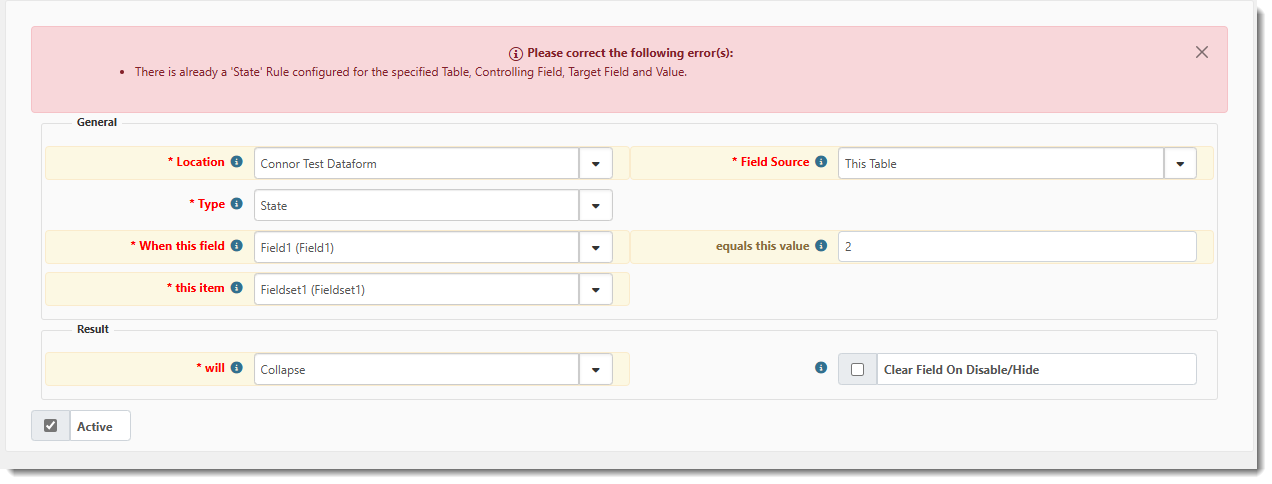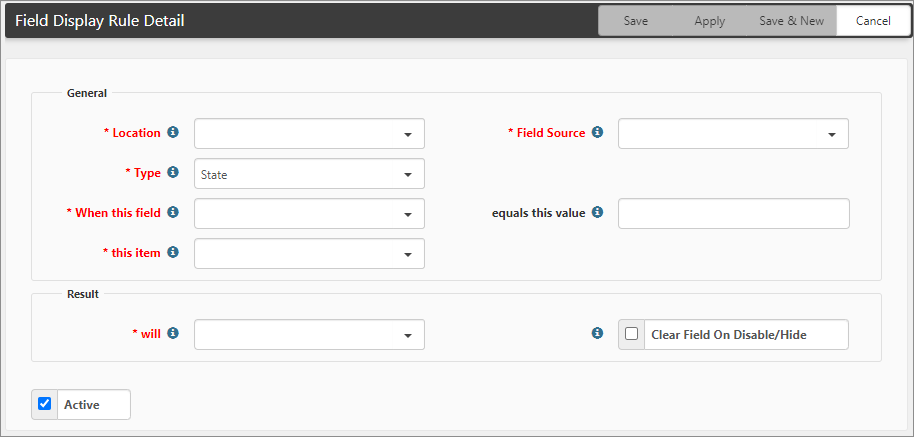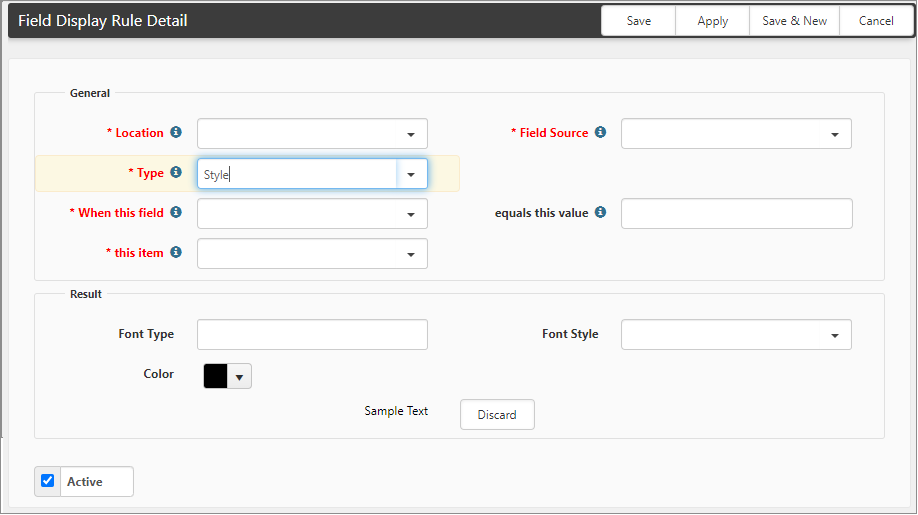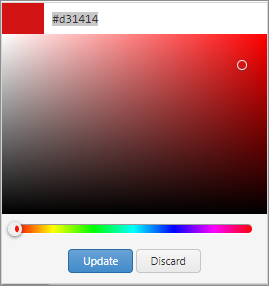Configuring Dynamic Field Display
Configurable field display provides an administrator with vast control over the general look and feel of a dataform. This is much more than just grouping fields into fieldsets or tabs but includes the ability to dynamically enable or disable fields and show or hide fields, fieldsets, or even tabbed dataforms based on the other data on that dataform. In combination with custom header links, an administrator can virtually set up any workflow or process in ClientSpace using dynamic field display.
When configuring field display, keep in mind what you would like to accomplish and map out how the result should work on your dataform. For example, when you select Organization as the Location, Organization fields can be made read-only or hidden based on configurable properties just as dataform fields. The source for these properties can be either based on Organization fields (where Field Source is This Table) or other related fields in ClientSpace using a field display proc (Field display Proc 1 or 2).
Field display can be cascaded. Combine this with required field rules, and it allows you to build incredibly complex workflows within a dataform. An example of this could be a form, where filling out a Pay Frequency field with a value of Weekly displays a Weekly payroll fieldset containing a required Pay Type field with values of Check or Direct Deposit. Selecting Direct Deposit displays a field for Bank Authorization, which is also required to save the form.
Required dataform fields hidden through configurable field display do not present their required attribute to the system’s dataform save logic, meaning these fields are only required if visible. This allows you to structure complex dataform logic and workflow within a dataform. This flexibility should be tempered with planning to ensure that appropriate data is captured when required. In short, make sure you are not hiding a required field (or a tab that contains a required field) that should be completed.
Field Display Validation
Validation for conflicts is in place to ensure that the target field does not already have a field display rule set up with a conflicting behavior. For instance, if a previous rule was set up to expand a fieldset and another rule that references the same Type, Field Source, controlling field (i.e., When this field), value (i.e., equals this value), and target field (i.e., this item) is set up to collapse the same fieldset on the same dataform, an error message similar to the following displays:
"There is already a 'State' Rule configured for the specified Table, Controlling Field, Target Field and Value."
This is illustrated in the image below:
The following ten behaviors are validated for conflicts:
| This behavior... | is validated to check for this conflicting behavior |
|---|---|
| Hide | Display |
| Hide | Expand |
| Hide | Collapse |
| Display | Hide |
| Disable | Enable |
| Enable | Disable |
| Expand | Collapse |
| Collapse | Expand |
Field Display Across Tabs
You can also configure dynamic field display rules across tabbed dataform relationships. This includes the following scenarios:
-
A field on a parent form triggers the display of a field on a tabbed child form.
-
A field on a tabbed child form triggers the display of a field on a parent form.
-
A field on a tabbed child form triggers the display of a field on another child tabbed form.
When you select a Location form of a parent or child dataform, this determines the fields available in the this item drop down list. When you select a Field Source of Form Data (i.e., the Location form), a parent form related to the Location form, or another child form related to the Location form, this determines the fields available for selection in the When this field drop-down list. Your ability to configure field display rules involving parent to tabbed child, tabbed child to parent or tabbed child to another tabbed child form depends on the selections in these fields.
Note: Tab: <DataformName> selections are only available in the Field Source drop-down list if the Location form has tabs. Selecting a tabbed form allows you to use a field from a tabbed child form as the triggering field.
Field Display Configuration
To configure and manage dynamic field display:
- Go to System Admin
 > Advanced > Manage Field Display.
> Advanced > Manage Field Display.
The Field Display Rule Search dashboard opens. It is helpful to filter the presented list for the dataform to which you are adding field display. This helps you to understand the existing field display logic and determine if this affects the changes you want to make. - When ready, click Add.
The Field Display Rule Detail form opens. This form provides a number of configuration options to customize your field display.
The following graphic illustrates the Field Display Rule Detail form when the Type field contains State.
The following graphic illustrates the Field Display Rule Detail form when the Type field contains Style.
- Complete the form:
|
General(fieldset) |
|
||||||||||||
|
Location |
Required. Select the location for which you would like to configure the field display. Many of the items on the list are dataforms. However, some are not, such as Organization. The Location selection affects several other choices on this form. |
||||||||||||
|
Field Source |
Required. Defaults to "Form Data" (formerly "This Table"). The available list of options is:
Note: A Field Display Proc is a custom SQL stored procedure that allows you to aggregate information from other dataforms in the system. For example, this allows you to disable all of the fields on workspace Employee and Employment forms if the Client Status on the Client Master page is Terminated. |
||||||||||||
|
Type |
Required. Determines whether this is a field display change that affects State or Styling:
|
||||||||||||
|
When this field |
Required. Presents a series of fields based on your choice of Location and Field Source. The selection in this field acts as the trigger for your field display action. |
||||||||||||
|
equals this value |
Required. This is the triggering value and should be set to something appropriate for the triggering field selected in When this field. For example, a check box selected as the triggering value should equal either True or 1 to trigger your field display off the checked state.
The value of a Lookup trigger field should equal the code value of either one of the lookup options or a comma-separated list of code values.
You can set the triggering value to #Empty or #NotEmpty to trigger the field display rule when the triggering field is empty (i.e., blank) or not empty (i.e., populated).
You can also build OR statements using a comma-separated list of values in this field for distinct value fields such as lookups, text, or parent form fields. Lets' say you have a lookup field to store the days of the week. To trigger field display for weekend days using equals this value as |
||||||||||||
|
this item |
Required. This is the field, fieldset, or tab upon which to perform the field display. |
||||||||||||
|
Result (fieldset) |
|
||||||||||||
|
will |
Note: This field only applies to Type of State. Required. Choose a field display action:
Note:
|
||||||||||||
|
Clear Field On Disable/Hide |
Note: This field displays in the Result fieldset when a user selects State in the Type field up in the General fieldset. Clear Field on Disable/Hide does precisely that. It removes any information previously stored in this field when it is hidden or disabled. This is a hard delete from the system, so exercise careful planning when choosing this option. Hiding a fieldset hides all fields within the fieldset, masking any required field actions for those fields.
This option is hidden when a tab is selected in When this field. |
||||||||||||
|
Font Type |
Note: This field displays in the Result fieldset when a user selects Style in the Type field up in the General fieldset. Select one or more of the following options:
|
||||||||||||
|
Font Style |
Note: This field displays in the Result fieldset when a user selects Style in the Type field up in the General fieldset. Select one of the following options:
|
||||||||||||
|
Color |
Note: This field displays in the Result fieldset when a user selects Style in the Type field up in the General fieldset. Select the color picker drop-down
|
||||||||||||
|
Sample Text |
Note: This field displays in the Result fieldset when a user selects Style in the Type field up in the General fieldset. The Sample Text is a preview of how the Font Type, Font Style and Color settings will display when applied.
If you do not approve of the current style settings, select the Discard button
|
- After you have configured all the field display options, click Save.
Examples
On the Organization, when the field DoNotCall is selected (equals 1), then the tab Org Other Info is hidden.
When the field named MultiTest has a value of 20 or 25, then the tab named Tab One is hidden.
When the Send Surveyfield is True (i.e., the checkbox is checked) on the parent form, the Customer Data field on the child tabbed form will display.








